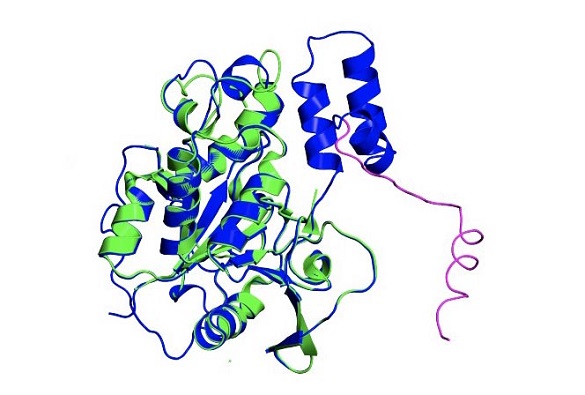Study discovers that Mpox virus protein H3L induces transcriptional perturbations and cellular injuries
Nikhil Prasad Fact checked by:Thailand Medical News Team Aug 23, 2024 1 year, 3 months, 2 weeks, 2 days, 8 hours, 27 minutes ago
Mpox News: Researchers from the Guangdong Provincial People’s Hospital and Guangdong Academy of Medical Sciences in China have made a groundbreaking discovery about the monkeypox (Mpox) virus (MPV). Their study uncovers how a specific protein, known as H3L, plays a critical role in causing cellular damage, which could be key to understanding the virus’s pathogenicity and developing effective treatments. This
Mpox News report delves into their findings, explaining the mechanisms by which the H3L protein induces injuries in cells and the implications for future therapeutic strategies.
 Mpox virus protein H3L induces transcriptional perturbations and cellular injuries
The Role of H3L in Monkeypox Virus Pathogenicity
Mpox virus protein H3L induces transcriptional perturbations and cellular injuries
The Role of H3L in Monkeypox Virus Pathogenicity
Monkeypox virus is a double-stranded DNA virus that has caused significant outbreaks globally, leading to over 89,000 reported cases and 150 deaths in recent years. Despite its impact, the mechanisms by which MPV causes disease in humans have remained unclear. Researchers focused on understanding how the virus inflicts cellular damage, particularly through its core proteins. This study zeroed in on the H3L protein and its role in disrupting normal cellular functions.
The research team conducted extensive experiments on human embryonic stem cells (hESCs) and mouse models. They overexpressed four core proteins of MPV - H3L, A35R, A29L, and I1L - to observe their effects on cell health. The results were striking: while several proteins caused some level of disruption, H3L stood out for its ability to induce significant transcriptional perturbations and cellular injuries.
How H3L Disrupts Cellular Functions
The researchers discovered that H3L upregulates the expression of IL1A, a pro-inflammatory cytokine, which then leads to cellular damage. The study demonstrated that when IL1A is blocked, the damage is significantly reduced, suggesting that IL1A plays a crucial role in the pathogenic effects of H3L.
Moreover, the study found that H3L perturbs the transcription of genes crucial for the cardiac system, leading to cardiac dysfunctions.
Mechanistically, H3L binds to the promoters of genes associated with cellular injury, altering the chromatin structure and causing gene expression disturbances. This binding alters the patterns of histone marks - specifically H3K27me3 and H3K4me3 - which are essential for regulating gene expression. The alterations in these histone marks result in the expression perturbations observed in the study.
The research team substantiated these findings using both in vitro and in vivo models, confirming that H3L induces significant transcriptional disturbances and cardiac dysfunction.
Implications for Therapeutic Strategies
The discovery of H3L’s role in causing cellular injuries opens new avenues for developing therapeutic strategies against MPV. By targeting IL1A, which is upregulated by H3L, it may be possible to mitigate the cellular damage caused by the virus. The study s
uggests that drugs designed to block IL1A could be a promising approach to treating MPV-associated injuries.
Furthermore, the research highlights the potential for developing vaccines or drugs that target the H3L protein itself. Given that H3L is a surface membrane protein, it is an accessible target for therapeutic interventions. The study's findings provide a comprehensive understanding of how MPV causes cellular damage, paving the way for more effective treatments in the future.
The Study's Broader Impact
The significance of this study extends beyond monkeypox. The methods and insights gained from this research could be applied to other viral infections, particularly those caused by viruses in the same family with similar mechanisms of action. By understanding how viral proteins like H3L disrupt cellular functions, scientists can develop broader antiviral strategies that target these proteins across different viruses.
Moreover, the study’s findings underscore the importance of investigating the specific proteins of viruses to understand their pathogenicity. This approach can reveal the precise mechanisms by which viruses cause disease, leading to more targeted and effective treatments. As MPV continues to circulate globally, the need for such research becomes increasingly urgent.
Conclusion
The study findings provide critical insights into the mechanisms by which the monkeypox virus causes cellular damage. By identifying the H3L protein as a key factor in inducing transcriptional perturbations and cellular injuries, the research opens up new possibilities for developing targeted therapies. Blocking IL1A, a downstream effector of H3L, emerges as a promising strategy for mitigating the damage caused by MPV. As this research progresses, it could lead to the development of more effective treatments for MPV and other viral infections.
The study findings were published in the peer-reviewed journal: Cell Death and Disease.
https://link.springer.com/article/10.1038/s41419-024-06990-2
For the latest
Mpox News, keep on logging to Thailand Medical News.
Read Also:
https://www.thailandmedical.news/news/the-structural-and-functional-insights-of-the-e5-helicase-protein-of-the-mpox-virus
https://www.thailandmedical.news/news/the-mpox-virus-s-f3-protein-triggers-immune-responses-and-apoptosis
https://www.thailandmedical.news/news/unveiling-the-role-of-monkeypox-mpox-virus-a23-protein-in-human-cells
https://www.thailandmedical.news/news/new-insights-into-understanding-mpox-s-evasion-of-the-immune-system
https://www.thailandmedical.news/news/breaking-ivermectin-users-will-likely-suffer-severe-or-lethal-mpox-infection-due-to-diminished-interferon-gamma
